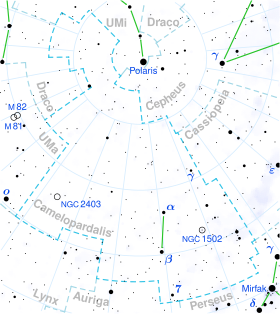HD 24733
| Observation data Epoch J2000[1] Equinox J2000[1] | |
|---|---|
| Constellation | Camelopardalis |
| Right ascension | 03h 58m 38.20939s |
| Declination | +53° 59′ 19.2990″ |
| Apparent magnitude (V) | 7.038[2] |
| Characteristics | |
| Spectral type | A3V[3] + G0V[4] |
| B−V color index | +0.22[1] |
| J−H color index | +0.052[1] |
| J−K color index | +0.090[1] |
| Variable type | Beta Lyrae variable |
| Astrometry | |
| Radial velocity (Rv) | 5.89 ± 9.72[5] km/s |
| Proper motion (μ) | RA: 8.560[6] mas/yr Dec.: -17.247[6] mas/yr |
| Parallax (π) | 5.3806 ± 0.0227 mas[6] |
| Distance | 606 ± 3 ly (185.9 ± 0.8 pc) |
| Orbit[7] | |
| Primary | HD 24733 A |
| Companion | HD 24733 B |
| Period (P) | 1.762838 d[4] |
| Eccentricity (e) | 0.084±0.015 |
| Inclination (i) | 67[4]° |
| Periastron epoch (T) | 2440489.71±0.04 |
| Argument of periastron (ω) (secondary) | 94±8° |
| Details[8] | |
| HD 24733 A | |
| Mass | 1.60 M☉ |
| Luminosity | 24.0 L☉ |
| Temperature | 7160 K |
| Other designations | |
| Database references | |
| SIMBAD | data |
HD 24733 is a spectroscopic binary system that is also a Beta Lyrae variable[4] located about 606 light-years (186 parsecs) away in the deep northern constellation of Camelopardalis, close to the border with Perseus. It has the variable-star designation DD Camelopardalis (sometimes abbreviated to DD Cam). With a mean apparent magnitude of 7.038, it is too faint to be seen by the naked eye from Earth, but readily visible through binoculars.[9]
Description
[edit]The primary star of the system is an A-type main-sequence star with a spectral type of A3V.[3] It has a mass of 2.16 M☉ and, at an effective temperature of 7,160 K (6,890 °C; 12,430 °F), radiates 24 times the luminosity of the Sun from its photosphere.[8] The star displays no chemical peculiarity.[10] The secondary star is thought to be a G-type main-sequence star with the spectral type G0V.[4]
HD 24733 was discovered to be a variable star by László Szabados, who observed the star at the Piszkéstető Station of Konkoly Observatory from late 1991 until early 1995.[4] It was independently discovered to be variable from the Hipparcos satellite data, and was given its variable star designation in 1999.[11] The two stars revolve around each other in a tight, nearly circular (eccentricity 0.084) orbit with a period of 1.762838 days (1 day, 18 hours, 18 minutes). As seen from Earth, one component periodically passes in front of the other, blocking some or all of its light. Hence, the star system appears to vary in brightness; from a maximum apparent magnitude of 6.97, it dips by 0.17 and 0.11 mag as each of the stars is obscured by its companion.[4]

The shape of the light curves imply that, because of their close proximity to one another, the two stars are both heavily distorted to an ellipsoidal shape due to mutual gravitational interactions. Additionally, the system may be surrounded by circumstellar material.[4]
See also
[edit]References
[edit]- ^ a b c d e "HD 24733". SIMBAD. Centre de données astronomiques de Strasbourg. Retrieved 6 November 2024.
- ^ Kervella, Pierre; Arenou, Frédéric; Mignard, François; Thévenin, Frédéric (2019). "Stellar and substellar companions of nearby stars from Gaia DR2". Astronomy & Astrophysics. 623. EDP Sciences: A72. arXiv:1811.08902. doi:10.1051/0004-6361/201834371. ISSN 0004-6361. Record for this entry at VizieR.
- ^ a b Abt, Helmut A. (23 December 2008). "Mk Classifications of Spectroscopic Binaries". The Astrophysical Journal Supplement Series. 180 (1). American Astronomical Society: 117–118. doi:10.1088/0067-0049/180/1/117. ISSN 0067-0049. Record for this entry at VizieR.
- ^ a b c d e f g h Szabados, L. (February 1997). "HD 24733 is an eclipsing spectroscopic binary". Astronomy & Astrophysics. 317: 786–788. Bibcode:1997A&A...317..786S.
- ^ Vallenari, A.; et al. (Gaia collaboration) (2023). "Gaia Data Release 3. Summary of the content and survey properties". Astronomy and Astrophysics. 674: A1. arXiv:2208.00211. Bibcode:2023A&A...674A...1G. doi:10.1051/0004-6361/202243940. S2CID 244398875. Gaia DR3 record for this source at VizieR.
- ^ a b c Brown, A. G. A.; et al. (Gaia collaboration) (2021). "Gaia Early Data Release 3: Summary of the contents and survey properties". Astronomy & Astrophysics. 649: A1. arXiv:2012.01533. Bibcode:2021A&A...649A...1G. doi:10.1051/0004-6361/202039657. S2CID 227254300. (Erratum: doi:10.1051/0004-6361/202039657e). Gaia EDR3 record for this source at VizieR.
- ^ Acker, A. (September 1971). "Orbital elements of the spectroscopic binaries HD 24733 and HD 861". Astronomy & Astrophysics (in French). 14: 189. Bibcode:1971A&A....14..189A.
- ^ a b Reiners, Ansgar; Zechmeister, Mathias (20 February 2020). "Radial Velocity Photon Limits for the Dwarf Stars of Spectral Classes F–M". The Astrophysical Journal Supplement Series. 247 (1). American Astronomical Society: 11. arXiv:1912.04120. Bibcode:2020ApJS..247...11R. doi:10.3847/1538-4365/ab609f. ISSN 0067-0049. Record for this entry at VizieR.
- ^ Zarenski, Ed (2004). "Limiting Magnitude in Binoculars" (PDF). Cloudy Nights. Archived (PDF) from the original on 21 July 2011. Retrieved 6 May 2011.
- ^ Budaj, J. (September 1996). "On the nature of the AM phenomenon or on a stabilization and the tidal mixing in binaries. I. Orbital periods and rotation". Astronomy & Astrophysics. 313: 523–531. Bibcode:1996A&A...313..523B.
- ^ Kazarovets, E. V.; Samus, N. N.; Durlevich, O. V.; Frolov, M. S.; Antipin, S. V.; Kireeva, N. N.; Pastukhova, E. N. (January 1999). "The 74th Special Name-list of Variable Stars" (PDF). Information Bulletin on Variable Stars. 4659: 1. Bibcode:1999IBVS.4659....1K. Retrieved 6 November 2024.
- ^ EAS (1997). "The HIPPARCOS and TYCHO catalogues". Astrometric and Photometric Star Catalogues Derived from the ESA Hipparcos Space Astrometry Mission. ESA SP Series. 1200. Noordwijk, Netherlands: ESA Publications Division. Bibcode:1997ESASP1200.....E. ISBN 9290923997. Retrieved 6 November 2024.

